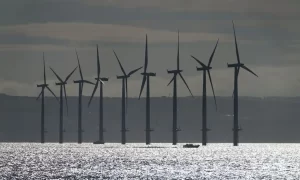
Floating windfarms could be built off the coasts of Cornwall and Pembrokeshire after the Queen’s property manager identified a clutch of sites in the Celtic Sea that could host them.
The crown estate, which generates money for the Treasury and the royal family, has published five “areas of search” that will be narrowed into development plots to host wind power generation.
Once the project development areas have been agreed, they will be offered to businesses through a tender process, which is due to be launched in mid-2023.
The crown estate hopes these areas will deliver 4 gigawatts of floating offshore wind power by 2035, fuelling almost 4m homes.
Offshore windfarms are typically built in the seabed close to the shore. The structures that could be hosted in the Celtic Sea allow turbines to be installed on floating concrete and steel platforms, which are anchored to the seabed using flexible anchors or cables and sit just above or below the waterline.
The innovation means they can be located in deeper water, creating less opposition from local residents and businesses onshore who dislike the presence of wind turbines on aesthetic grounds. It also means the structures benefit from stronger winds and are less likely to cause conflict with fishing fleets, or disruption to birds’ nesting grounds and naval bases.
The crown estate said it had identified the areas of search by studying various factors including “navigation routes, fisheries activity and environmental sensitivities”. The windfarms will not be visible from land apart from one potential site north of the Isles of Scilly, it said.
In a meeting with interested parties earlier this year, concerns were raised over whether the floating windfarms would cause problems for fishing equipment on vessels fishing crab and lobster in the area. There were also calls for the size of the buffer zones between the farms and nearby boats to be expanded.
The windfarms could also be co-located with carbon capture and storage schemes or coordinate activities with telecoms cabling projects, stakeholders said.
Last month, the crown estate said a record-breaking auction of plots for offshore windfarms had pushed up the value of its marine business by 22% on last year to £5bn.
Separate to its ambitions in the Celtic Sea, the estate awarded licences for six offshore windfarms off the coast of England and Wales that could generate up to £9bn over the next 10 years. The successful bidders included Germany’s RWE Renewables and a consortium, which includes the oil company BP.
Profits for the crown estate, jumped by £43.4m to £312.7m in the year to the end of March.
The estate hands all of its profits to the Treasury before 25% is returned to the royal household in the form of the sovereign grant, a funding formula that is under government review. The grant was increased in 2017 from its previous level of 15% to pay for extensive renovations at Buckingham Palace.
Huub den Rooijen, the managing director marine at the crown estate, said: “The Celtic Sea has the potential to become one of the great renewable energy basins of the world, bringing economic growth and abundant clean power.”
The energy minister, Greg Hands, said: “We already have the largest offshore wind deployment in Europe. Floating technology is key to unlocking the full potential of our coastline.”
Earlier this year the crown estate’s Scottish arm auctioned sea space to 17 projects, with most of the capacity earmarked for offshore wind. The first floating offshore windfarm has been in operation off Scotland since 2017.
Read more:
Floating windfarms could be hosted off Cornwall and Wales, crown estate says





